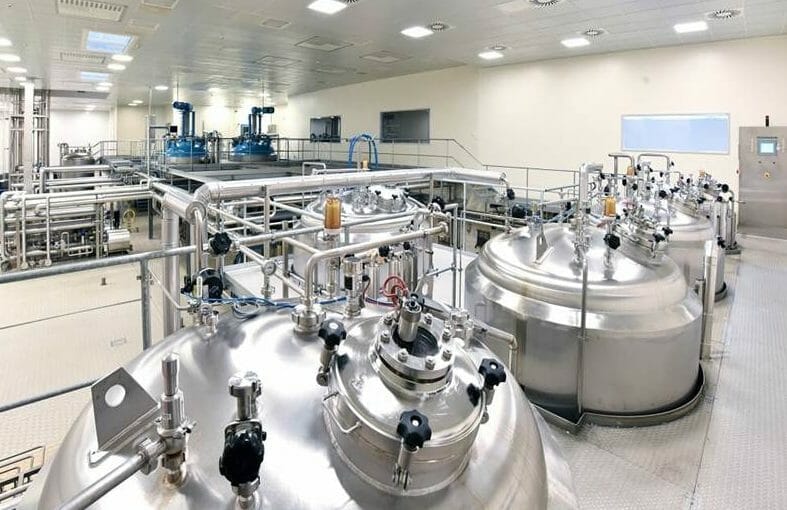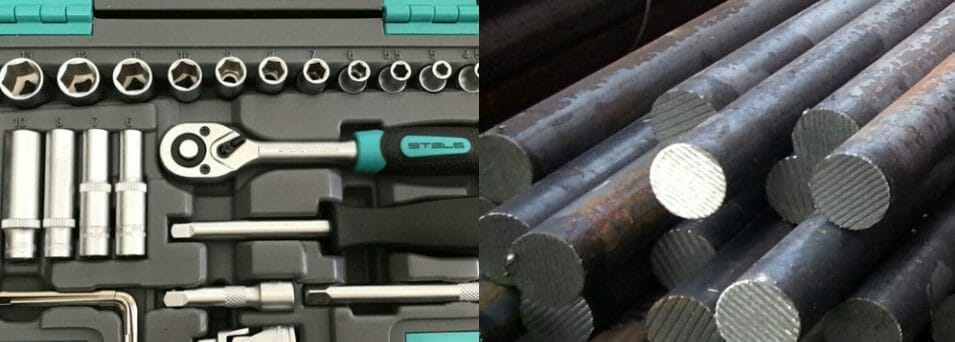Welcome to our in-depth comparison of two popular types of steel: chrome vanadium steel and stainless steel. Both of these materials have unique properties that make them well-suited for a variety of applications, but they differ in terms of strength, durability, and cost. In this article, we’ll take a closer look at the characteristics of each type of steel and explore the ideal applications for each. By the end of this article, you’ll have a better understanding of which type of steel is right for your needs.
Key Takeaways:
- Chrome vanadium steel and stainless steel are two popular types of steel with unique characteristics.
- Chrome vanadium steel is known for its high strength and durability, making it ideal for applications such as tools, automotive parts, and construction equipment.
- Stainless steel is resistant to corrosion and oxidation, making it ideal for a wide range of applications, including kitchenware, medical instruments, and architectural structures.
- When choosing between these two types of steel, it’s important to consider factors such as cost, durability, and specific application requirements.
What is Chrome Vanadium Steel?
Chrome vanadium steel, also known as Cr-V steel, is a high-quality alloy steel that is primarily made up of chromium, vanadium, and carbon. This type of steel is renowned for its exceptional strength, durability, and resistance to wear and tear.
Chrome vanadium steel is commonly used for manufacturing tools, such as wrenches, sockets, and pliers, due to its toughness and ability to withstand high levels of stress. It also has a high corrosion resistance and can maintain its shape even under extreme temperatures, making it suitable for use in automotive parts and construction equipment.
What is Stainless Steel?
Stainless steel is a popular alloy composed of iron, carbon, and at least 10.5% chromium. Other metals, such as nickel, molybdenum, and titanium, may also be added to enhance its properties.
One of the most notable characteristics of stainless steel is its ability to resist corrosion and oxidation, making it a highly sought-after material in various industries, such as construction, architecture, and food production.
Stainless steel is also known for its high strength-to-weight ratio, making it an excellent choice for applications where both strength and durability are required. Additionally, it is easy to clean and maintain, and its shiny surface gives it an attractive appearance, making it a popular choice for kitchenware and decorative items.
Strength Comparison: Chrome Vanadium Steel vs Stainless Steel
When it comes to strength, both chrome vanadium steel and stainless steel have unique properties that set them apart. Chrome vanadium steel is known for its exceptional strength and hardness, making it ideal for heavy-duty applications such as tools and automotive parts. On the other hand, stainless steel is prized for its resistance to corrosion and oxidation, making it suitable for a range of applications from kitchenware to architectural structures.

| Chrome Vanadium Steel | Stainless Steel | |
|---|---|---|
| Strength | Chrome vanadium steel is incredibly strong and durable, with a high hardness rating that allows it to withstand heavy use and resist deformation. | While not as hard as chrome vanadium steel, stainless steel is still very strong and has excellent resistance to corrosion and oxidation. |
| Toughness | Chrome vanadium steel has excellent toughness and can withstand heavy impacts without cracking or breaking. | Stainless steel has good toughness but is not as impact-resistant as chrome vanadium steel. |
| Cost | Chrome vanadium steel is generally less expensive than stainless steel, making it a popular choice for cost-sensitive applications. | Stainless steel is more expensive than chrome vanadium steel due to its unique composition and manufacturing process. |
| Appearance | Chrome vanadium steel has a dull gray appearance and is not as visually appealing as stainless steel. | Stainless steel has a shiny, metallic appearance that is often desired for decorative and aesthetic applications. |
Ultimately, the choice between chrome vanadium steel and stainless steel depends on the specific application and its requirements. For heavy-duty applications that require exceptional strength and toughness, chrome vanadium steel is likely the best choice. For applications that require resistance to corrosion and oxidation, stainless steel is the clear winner. In cases where appearance or cost are important factors, the decision may be less straightforward and require careful consideration of all the relevant factors.
Ideal Applications for Chrome Vanadium Steel

Chrome vanadium steel is an excellent choice for applications that require high strength, toughness, and wear resistance. Here are some of the most common applications where chrome vanadium steel excels:
- Tools: Chrome vanadium steel is widely used in the manufacturing of hand tools, such as wrenches, screwdrivers, and pliers, due to its ability to withstand heavy use and resist deformation.
- Automotive Parts: Many high-stress components in automotive engines and suspension systems are made from chrome vanadium steel, such as valve springs, piston rods, and sway bars.
- Construction Equipment: Chrome vanadium steel is often used in the manufacturing of construction equipment, such as bulldozers, excavators, and cranes, due to its ability to withstand heavy loads and resist deformation.
- Springs: Chrome vanadium steel is a popular choice for springs that require high strength, durability, and resistance to fatigue, such as those used in firearms, industrial machinery, and transportation equipment.
Overall, chrome vanadium steel is an excellent choice for applications that require high strength, durability, and toughness under heavy loads.
Ideal Applications for Stainless Steel

Stainless steel is a highly versatile material that is widely used in many different industries. Its unique combination of strength, durability, and corrosion resistance makes it an ideal choice for a wide range of applications. Here are some of the most common uses for stainless steel:
- Kitchenware: Stainless steel is the go-to material for many types of cookware, cutlery, and appliances due to its hygienic properties, resistance to staining and corrosion, and sleek appearance.
- Medical instruments: Stainless steel is used extensively in the medical industry for surgical instruments, dental instruments, and implants due to its biocompatibility and resistance to corrosion.
- Architectural structures: Stainless steel is a popular choice for building facades, handrails, and other architectural features due to its durability, low maintenance requirements, and aesthetic appeal.
- Automotive parts: Stainless steel is used in automotive manufacturing for exhaust systems, trim, and other components due to its high heat resistance and corrosion resistance.
- Jewelry: Stainless steel is commonly used in jewelry due to its durability, resistance to tarnishing, and affordability compared to precious metals.
Overall, stainless steel is a reliable and versatile material that can be used in many different applications where strength, durability, and resistance to corrosion are required.
Can You Chrome Plate Stainless Steel?
One common question that arises when comparing chrome vanadium steel and stainless steel is whether it is possible to chrome plate stainless steel. The short answer is yes, it is possible, but it can be a challenging process.
Stainless steel is known for its resistance to corrosion and oxidation, and this can make it difficult to achieve a good bond between the material and the chrome plating. The surface of the stainless steel must first be properly cleaned and prepared before the plating process can begin. This typically involves removing any contaminants and roughening the surface to ensure a strong adhesion.
Another factor to consider is that the chrome plating is not actually applied directly to the stainless steel. Instead, a layer of nickel is first applied to the stainless steel to provide a better surface for the chrome plating to adhere to. This additional step adds time and expense to the process.
Overall, while it is possible to chrome plate stainless steel, it is not always the most practical option. For applications where a highly polished or mirror-like finish is not required, it may be more cost-effective to simply use chrome vanadium steel or another material altogether.
Read More : Can You Chrome Plate Stainless Steel? Expert Answers & Tips
Factors to Consider When Choosing Between Chrome Vanadium Steel and Stainless Steel
When deciding between chrome vanadium steel and stainless steel for a particular application, there are several important factors to consider. By taking these into account, you can make an informed decision that meets your needs in terms of durability, performance, and cost.

Composition and Properties
One of the primary differences between chrome vanadium steel and stainless steel is their composition and resulting properties. Chrome vanadium steel is an alloy that contains chromium, vanadium, and carbon, which provide exceptional strength and durability. Stainless steel, on the other hand, is a steel alloy that contains chromium, nickel, and often molybdenum, which gives it high corrosion resistance and a bright, smooth finish.
Strength and Durability
When it comes to overall strength and durability, chrome vanadium steel is generally considered to be superior to stainless steel. This makes it ideal for applications that require high strength and resistance to wear and tear, such as tools, automotive parts, and heavy machinery. However, stainless steel is highly resistant to corrosion and oxidation, making it a better choice for applications that require resistance to these factors, such as kitchenware and medical instruments.
Cost
The cost of chrome vanadium steel and stainless steel can vary depending on a number of factors, including the specific grade or alloy, the quantity required, and the current market conditions. Generally speaking, chrome vanadium steel is more affordable than stainless steel, making it a popular choice for applications where cost is a significant factor. However, it’s important to remember that the initial cost is not always the only cost to consider, as factors such as maintenance and replacement costs can also come into play.
Specific Application Requirements
Ultimately, the choice between chrome vanadium steel and stainless steel will depend on the specific requirements of your application. Consider factors such as the environment in which the material will be used, the level of wear and tear it will be subjected to, and the desired appearance and finish. Consulting with a materials expert or a trusted supplier can also be helpful in selecting the right material for your needs.
Pros and Cons of Chrome Vanadium Steel
Chrome vanadium steel is a popular choice for applications that require high strength and durability. Here are some of the pros and cons of using this type of steel:
| Pros | Cons |
|---|---|
| High strength: Chrome vanadium steel is known for its exceptional strength, making it ideal for heavy-duty applications. | Less corrosion-resistant: While chrome vanadium steel is durable, it is not as resistant to corrosion as stainless steel. |
| Cost-effective: Compared to other high-strength alloys, chrome vanadium steel is relatively affordable and widely available. | Not ideal for high-temperature applications: Chrome vanadium steel can become brittle at high temperatures, making it less suitable for certain applications. |
| Toughness: Chrome vanadium steel has a high level of toughness, which allows it to withstand impact and fatigue better than many other types of steel. | May require special treatment: Depending on the application, chrome vanadium steel may require heat treatment or other special processing to achieve optimal strength and durability. |
Overall, chrome vanadium steel is a strong and cost-effective option for applications that require high strength and toughness but do not require corrosion resistance or high-temperature performance.
Pros and Cons of Stainless Steel
Stainless steel offers a number of advantages, making it a popular choice in a variety of applications. Here are some of its pros:
- Corrosion resistance: Stainless steel is highly resistant to corrosion, making it perfect for use in harsh environments where other materials would quickly deteriorate.
- Hygienic: The non-porous surface of stainless steel makes it easy to clean and disinfect, making it an ideal choice for use in the food and medical industries.
- Durable: Stainless steel is incredibly strong and durable, able to withstand heavy use and extreme temperatures without damage.
- Aesthetically pleasing: Stainless steel has a sleek, modern look that is highly sought after in design and architecture.
However, there are also some downsides to stainless steel that should be considered:
- Expensive: Stainless steel can be more expensive than other materials, especially for high-quality grades.
- Heavy: The density of stainless steel can make it heavy and difficult to work with, especially in large structures or equipment.
- Less malleable: Stainless steel is more difficult to shape and form than other materials, which can limit its uses in certain applications.
- Difficult to weld: Welding stainless steel can be challenging due to its high melting point and susceptibility to warping and distortion.
Conclusion
After comparing the strengths and ideal applications of chrome vanadium steel versus stainless steel, it becomes clear that both materials have their own unique advantages and disadvantages.
Chrome vanadium steel is known for its exceptional strength and durability, making it the ideal choice for applications such as tools, automotive parts, and construction equipment. However, it may not be the best choice for certain applications due to its potential for rusting and corrosion.
On the other hand, stainless steel is highly resistant to corrosion and oxidation, making it the go-to material for applications in the medical industry, kitchenware, and architectural structures. It may not be as strong as chrome vanadium steel, but its resistance to corrosion makes it highly reliable in the long run.
Factors to Consider
When deciding between chrome vanadium steel and stainless steel, there are several factors that should be taken into account, such as cost, durability, and specific application requirements.
It’s important to weigh the pros and cons of each material carefully before making a decision. Consider the intended application, the environment in which it will be used, and the budget available for the project.
Ultimately, the choice between chrome vanadium steel and stainless steel depends on the specific needs and requirements of the application. Both materials have their own unique strengths, and choosing between them requires careful consideration of all relevant factors.
With this knowledge in mind, you can confidently choose the right material for your project and ensure optimal performance and longevity.
Can wearing stainless steel earrings cause an allergic reaction?
Allergic reactions to stainless steel earrings are possible. Some people may be sensitive to the nickel content in stainless steel, which can lead to symptoms like itching, redness, and swelling. To avoid this, opt for hypoallergenic or nickel-free earrings, or try wearing a clear nail polish on the earrings to create a barrier between the skin and the metal.
FAQ
Q: Chrome Vanadium Steel vs Stainless Steel: Comparing Strengths
A: This section will provide an overview of the article, introducing the topic of comparing chrome vanadium steel and stainless steel in terms of their strengths and ideal applications.
Q: What is Chrome Vanadium Steel?
A: Chrome vanadium steel is a type of steel alloy that contains chromium and vanadium, which enhance its strength and durability. It is commonly used in applications where high strength and toughness are required, such as tools, automotive parts, and construction equipment.
Q: What is Stainless Steel?
A: Stainless steel is a alloy that contains a minimum of 10.5% chromium, which creates a protective layer on its surface, making it highly resistant to corrosion and oxidation. It is widely used in various applications, including kitchenware, medical instruments, and architectural structures.
Q: Strength Comparison: Chrome Vanadium Steel vs Stainless Steel
A: When comparing the strength characteristics of chrome vanadium steel and stainless steel, chrome vanadium steel generally has higher tensile strength and toughness, while stainless steel excels in terms of corrosion resistance. The choice between the two depends on the specific application requirements.
Q: Ideal Applications for Chrome Vanadium Steel
A: Chrome vanadium steel is commonly used in applications where high strength and durability are crucial. It is ideal for manufacturing tools, automotive parts, construction equipment, and other heavy-duty components.
Q: Ideal Applications for Stainless Steel
A: Stainless steel is versatile and widely used in many industries. It is commonly found in kitchenware, medical instruments, architectural structures, and even in aerospace and marine applications due to its corrosion resistance and hygienic properties.
Q: Can You Chrome Plate Stainless Steel?
A: Yes, it is possible to chrome plate stainless steel. However, the process can be challenging due to stainless steel’s resistance to traditional plating processes. Specialized techniques may be required to achieve a successful chrome plating on stainless steel surfaces.
Q: Factors to Consider When Choosing Between Chrome Vanadium Steel and Stainless Steel
A: When deciding between chrome vanadium steel and stainless steel, several factors should be considered. These include cost, strength requirements, corrosion resistance, durability, and the specific application in which the steel will be used.
Q: Pros and Cons of Chrome Vanadium Steel
A: Chrome vanadium steel offers excellent strength, toughness, and wear resistance. However, it may be more expensive than other steel options, and its hardness can present challenges during machining or shaping processes.
Q: Pros and Cons of Stainless Steel
A: Stainless steel is highly corrosion-resistant, easy to clean, and has a pleasing aesthetic appearance. However, it can be relatively expensive compared to other steel options, and certain grades may have limitations in terms of strength and hardness.






